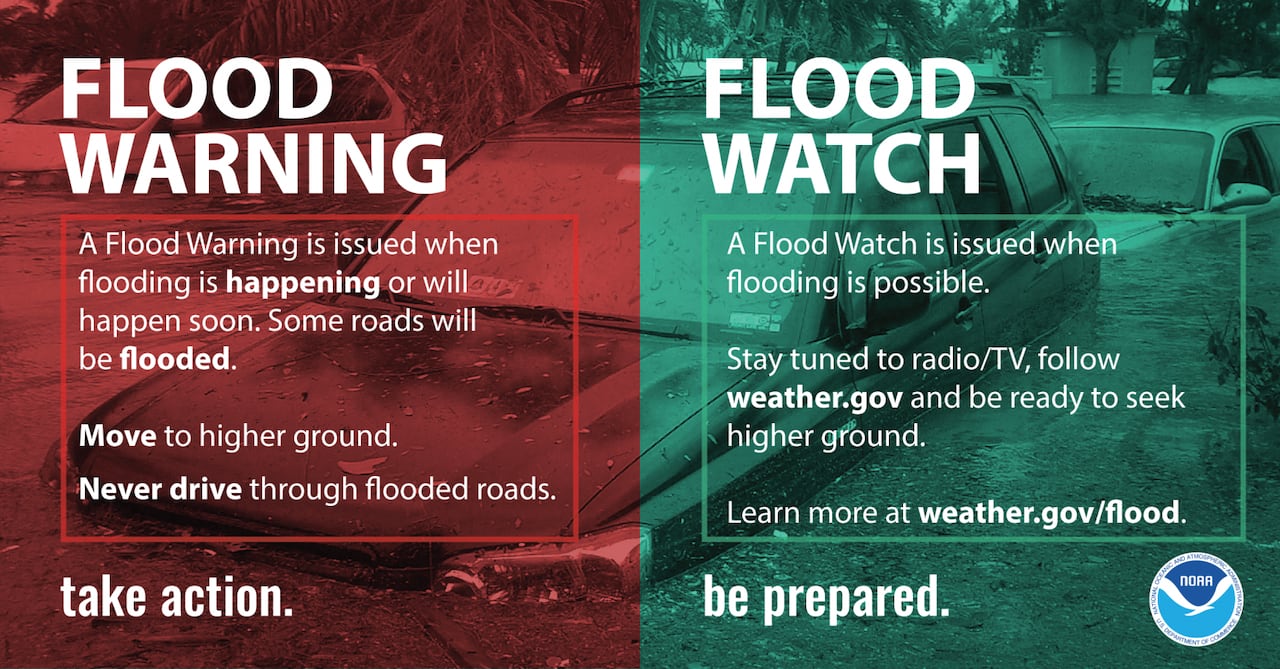How To Interpret And React To Flood Alerts

Table of Contents
Flooding is a devastating natural disaster, causing significant property damage and posing serious risks to life. Understanding and reacting appropriately to flood alerts is crucial for protecting yourself and your loved ones. This guide will equip you with the knowledge to interpret different levels of flood alerts and take effective action to mitigate the risks. Learning how to respond to flood warnings can be the difference between safety and serious danger. This comprehensive guide will cover everything you need to know about flood alerts, from understanding the different warning levels to creating a comprehensive flood preparedness plan.
<h2>Understanding Different Flood Alert Levels</h2>
Knowing the difference between various flood alerts is the first step in effective flood preparedness. Different alerts indicate different levels of risk and require different responses. Ignoring these alerts can have severe consequences.
<h3>What Flood Watches Mean</h3>
A flood watch means that conditions are favorable for flooding to occur. It's not an immediate threat, but it's a strong indication that flooding is possible within the specified timeframe. Think of it as a yellow light – proceed with caution.
- Increased risk of flooding: Pay close attention to weather reports and local news.
- Monitor conditions and prepare: Gather essential supplies, charge electronic devices, and secure loose objects around your property.
- Gather emergency supplies: This includes water, non-perishable food, medications, and important documents. Have a plan for your pets.
<h3>Responding to Flood Warnings</h3>
A flood warning is serious. This means flooding is imminent or already occurring. Immediate action is required to protect yourself and your property.
- Flooding is imminent or occurring: This is not the time to hesitate.
- Evacuate if instructed: Obey evacuation orders immediately. Don't wait to see if the flood will affect you.
- Move valuable items to higher ground: Move furniture, electronics, and other valuables to upper floors or a safe location.
- Disconnect electrical appliances: This helps prevent electrical shock and damage to appliances.
<h3>The Significance of Flood Advisories</h3>
A flood advisory indicates that minor flooding is occurring or is expected. While the risk is lower than with a warning, it still warrants caution.
- Minor flooding is occurring or expected: Be aware of potential hazards and avoid flood-prone areas.
- Be cautious near flood-prone areas: Stay away from rivers, streams, and low-lying areas.
- Stay informed about updates: Continue to monitor weather reports and official announcements.
<h3>Emergency Alerts and Notifications</h3>
Leveraging technology can significantly improve your awareness of impending flood threats.
- Sign up for emergency alerts: Register with your local emergency management agency to receive alerts via text, email, or phone calls. This ensures you’re among the first to receive crucial flood information.
- Download relevant weather apps: Many weather apps provide real-time flood warnings and forecasts.
- Stay informed through multiple channels: Use a combination of methods to receive alerts for comprehensive coverage – radio, TV, and online news sources in addition to your phone alerts.
<h2>Creating a Flood Preparedness Plan</h2>
Proactive planning is vital in mitigating the impact of flooding. Having a well-defined plan can save lives and reduce property damage.
<h3>Building an Emergency Kit</h3>
Assemble a comprehensive emergency kit containing essential supplies that will sustain you and your family for several days.
- Sufficient water: At least one gallon per person per day for several days.
- Non-perishable food items: Choose foods that require no refrigeration and are easy to prepare.
- First-aid kit with essential supplies: Include bandages, antiseptic wipes, pain relievers, and any necessary medications.
- Important documents (copies): Keep copies of insurance policies, identification, and other crucial documents in a waterproof container.
- Flashlight and extra batteries: Essential for navigating in dark and flooded areas.
- Radio (battery-powered): Stay updated on weather and emergency broadcasts.
<h3>Developing an Evacuation Plan</h3>
Knowing how and where to evacuate in case of a flood is crucial. Practice your plan so everyone in the household knows what to do.
- Identify multiple evacuation routes: Plan alternate routes in case your primary route is blocked.
- Establish a meeting point for family members: Choose a location outside your immediate area where you can reunite if separated.
- Practice the evacuation plan regularly: Familiarize your family with the plan and regularly practice evacuation drills.
<h3>Protecting Your Property</h3>
Taking proactive steps to protect your property can significantly reduce flood damage.
- Elevate valuable items: Move furniture and appliances to higher levels.
- Seal basement windows and doors: Prevent water from entering your basement.
- Consider flood insurance: Flood insurance can help cover the costs of repairs and replacement of damaged property. Check your homeowner’s insurance policy to understand your coverage for flood damage.
<h2>Safe Practices During and After a Flood</h2>
Your actions during and after a flood are critical for ensuring your safety and minimizing further damage.
<h3>Actions During a Flood</h3>
Prioritize your safety and take appropriate precautions during a flood event.
- Never drive or walk through floodwaters: Floodwaters can be deceptively deep and may contain hidden dangers.
- Stay away from downed power lines: Downed power lines pose a serious electrocution risk.
- Be aware of potential hazards: Floodwaters can contain debris, sharp objects, and contaminated water.
<h3>Post-Flood Safety</h3>
Once the floodwaters recede, there are still several safety precautions to take.
- Report any damage to authorities: Contact your local emergency management agency to report damage and request assistance.
- Check for gas leaks and electrical hazards: Before re-entering your home, inspect for gas leaks and electrical hazards.
- Avoid contact with floodwater: Floodwater can be contaminated with sewage and other hazardous materials.
- Be cautious of structural damage: Buildings may have suffered structural damage, so exercise caution when entering your home.
<h3>Cleaning up After a Flood</h3>
Cleaning up after a flood requires careful planning and the use of appropriate safety measures.
- Wear protective gear: Wear rubber boots, gloves, and a mask to protect yourself from contaminated water and debris.
- Discard contaminated items properly: Dispose of soaked furniture, carpets, and other items according to local guidelines.
- Use appropriate cleaning solutions: Use disinfectants to thoroughly clean and sanitize affected areas.
<h2>Conclusion</h2>
Understanding and responding effectively to flood alerts is crucial for protecting your safety and property. By familiarizing yourself with different alert levels, creating a comprehensive preparedness plan, and following safe practices during and after a flood, you can significantly reduce the risks associated with this devastating natural hazard. Don't wait for a flood warning—start preparing today by learning more about how to interpret and react to flood alerts and building your preparedness plan. Remember, being proactive is your best defense against the dangers of flooding. Take control of your safety and develop your flood alert response strategy today.

Featured Posts
-
 Addressing Oem Concerns Sg Wireless Expands Manufacturing Collaborations
May 26, 2025
Addressing Oem Concerns Sg Wireless Expands Manufacturing Collaborations
May 26, 2025 -
 Wrongful Glasgow Airport Arrest Feature Film In The Works
May 26, 2025
Wrongful Glasgow Airport Arrest Feature Film In The Works
May 26, 2025 -
 The La Wildfires And The Disturbing Trend Of Betting On Natural Calamities
May 26, 2025
The La Wildfires And The Disturbing Trend Of Betting On Natural Calamities
May 26, 2025 -
 Atletico Madrid In Zorlu Zaferi Hakem Kararlari Ve Espanyol Un Oyunu
May 26, 2025
Atletico Madrid In Zorlu Zaferi Hakem Kararlari Ve Espanyol Un Oyunu
May 26, 2025 -
 F1 Drivers Press Conference Key Moments And Highlights
May 26, 2025
F1 Drivers Press Conference Key Moments And Highlights
May 26, 2025
